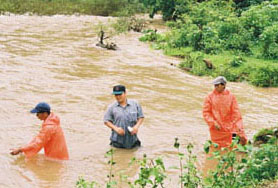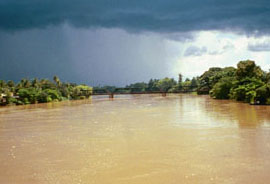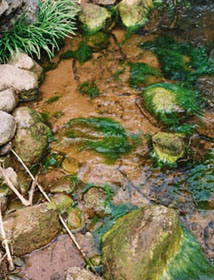5.3 WATER CHEMISTRY AND THE CATCHMENT
Water chemistry / Land use and nutrients / Organic matter and suspended loads / Seasonal and spatial variations in water chemistry / Human impacts - pollution / Persistent organic pollutants (POPs)) / Human impacts - impoundments and water chemistry
 Many
factors influence the chemical composition of river water, causing variation
from place to place. Mountain streams appear pure, farm creeks are often
muddy and drainages in limestone rich regions are fertile while those
containing only granitic rocks are usually less so. The rivers and even
the rain of heavily populated areas, may be polluted by human activities.
Many
factors influence the chemical composition of river water, causing variation
from place to place. Mountain streams appear pure, farm creeks are often
muddy and drainages in limestone rich regions are fertile while those
containing only granitic rocks are usually less so. The rivers and even
the rain of heavily populated areas, may be polluted by human activities.
The biological consequences of chemical variation within freshwaters may
not be significant when conditions are reasonably close to the average.
However, when extremes occur, due to natural causes or human influence,
chemical variation from place to place can be biologically significant.
Precipitation--
Precipitation (e.g., rain and snow) is a source of chemical inputs to
rivers and streams. Water flowing through a region of relatively insoluble
rocks can be chemically very similar to precipitation in its composition.
Natural precipitation contains a wide variety of dissolved substances
including low concentrations of carbonic acid  due
to atmospheric carbon dioxide dissolving in the water droplets (see earlier
section on pH, Alkalinity and Acidity). Precipitation not only contains
dissolved atmospheric gases (carbon dioxide, nitrogen and oxygen) but
also contains appreciable amounts of sodium, potassium, calcium, magnesium,
chloride and sulphate, particularly in coastal areas.
due
to atmospheric carbon dioxide dissolving in the water droplets (see earlier
section on pH, Alkalinity and Acidity). Precipitation not only contains
dissolved atmospheric gases (carbon dioxide, nitrogen and oxygen) but
also contains appreciable amounts of sodium, potassium, calcium, magnesium,
chloride and sulphate, particularly in coastal areas.
In the presence of atmospheric pollution, rain can be even more acidic
as a result of sulphur dioxide and nitrous oxide gasses dissolving to
produce sulphuric and nitric acids which the popular media has termed
'acid rain'. Sea salts reach the atmosphere in spray and can also be transported
long distances. Where rain reaches streams with little contact with soils,
as in bogs or some tropical rainforest habitats, the streams will have
low mineral content and be slightly more acidic than the rain itself.
However, it is more likely that rain has been in contact with vegetation
and soils before reaching the stream where it may undergo considerable
chemical alteration.
Water Chemistry--
The actual chemical composition of stream and river water depends on the
interplay of several variables that are unique to each river catchment
and even to tributary sub-catchments. These include:
• the initial chemical composition of contributing precipitation, the amount and distribution of rain and snowfall related to its proximity to coastal regions, to industry, and to climate;
• the nature of the surrounding catchment and movement of water from the catchment to the river related to topography, geology, soils and vegetation and to the contribution of groundwater;
• the distance from headwaters and time (season or even time of day or time of last rainfall); and
• the influence of human activity and land use in the catchment, such as agriculture, forestry and urbanization.
Land Use and Nutrients--
In addition to carbon dioxide and water, aquatic plants require a variety
of other compounds to survive. The most important of these elements are
nitrogen and phosphorus. Additional nutrients, such as potassium, iron,
selenium, and silica are needed in smaller amounts and generally are not
limiting factors to plant growth. Phosphorus in freshwater systems exists
in either a particulate phase or a dissolved phase, and may include both
organic and inorganic fractions. The organic particulate phase includes
living and dead particulate matter. Inorganic particulate phosphorus includes
phosphorus precipitates and  phosphorus
adsorbed to particulates. Dissolved organic phosphorus includes organic
phosphorus excreted by organisms and colloidal phosphorus compounds. The
soluble inorganic phosphorus forms H2PO4-,
HPO42-
and PO43-,
collectively known as soluble reactive phosphorus (SRP) and are readily
available to plants. Similarly, nitrogen can exist in several different
forms in the aquatic environment; dissolved nitrogen gas (N2),
ammonia and ammonium ion (NH3 and NH4+),
nitrite (NO2-),
nitrate (NO3-),
and organic nitrogen. The most important forms on nitrogen in terms of
their immediate impacts on water quality are the readily available ammonia
ions, nitrites, and nitrates.
phosphorus
adsorbed to particulates. Dissolved organic phosphorus includes organic
phosphorus excreted by organisms and colloidal phosphorus compounds. The
soluble inorganic phosphorus forms H2PO4-,
HPO42-
and PO43-,
collectively known as soluble reactive phosphorus (SRP) and are readily
available to plants. Similarly, nitrogen can exist in several different
forms in the aquatic environment; dissolved nitrogen gas (N2),
ammonia and ammonium ion (NH3 and NH4+),
nitrite (NO2-),
nitrate (NO3-),
and organic nitrogen. The most important forms on nitrogen in terms of
their immediate impacts on water quality are the readily available ammonia
ions, nitrites, and nitrates.
When light is adequate and current not too swift, long plumes of dense,
filamentous algae signal the presence of excessive nutrients. The impacts
of those nutrients can be very serious because after an algal bloom comes
death, sinking and decay. The result can be an anoxic zone in the deeper
waters caused by bacterial metabolism and is no different that what would
occur if sewage were discharged into a water body.
Increased nutrient concentration are a serious and well-known consequence
of a greater human presence and changing land uses within a watershed.
Agriculture increases nutrient levels due to fertilizers and animal wastes,
and also by increasing soil erosion, which particularly affects the transport
of phosphorus. Municipal wastes and fertilizers are significant nutrient
sources from urban areas.
It is clear that the extent of vegetation and human land use practices
in the watershed regulates the levels of nutrients reaching the aquatic
environment.
Organic Matter and Suspended
Loads--
Particulate organic matter enters streams as whole branches, leaf litter,
bud scales, flowers and pollen from overhanging and surrounding vegetation
and as finely divided soil humus and animal wastes through bank erosion
and chance inputs. Large amounts of organic and inorganic materials can
be washed into rivers and transported long distances. Inorganic suspended
solids originate from terrestrial sources through soil disturbance followed
by heavy rainfall and subsequent bank erosion. The significance of suspended
solids relates largely to the effects on subsurface light levels and indirectly
to the nature of the substrate. The nature of suspended (and dissolved)
materials conveys optical properties that can be used to classify rivers
as
• Blackwater rivers are poor in dissolved inorganic and suspended solids, but dissolved organic matter produces a reddish-brown colour. These are typically of low pH.
• Whitewater rivers have high levels of suspended solids with a muddy/silty appearance, as well as high levels of dissolved inorganic solids, tending to be alkaline.
• Clearwater rivers vary in acidity and have little suspended material.